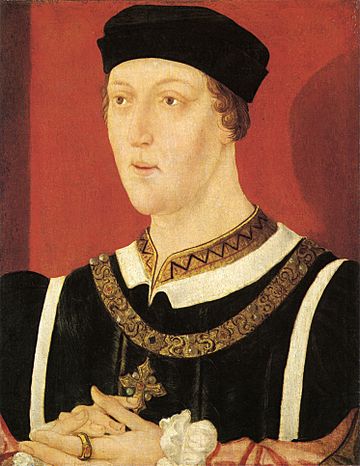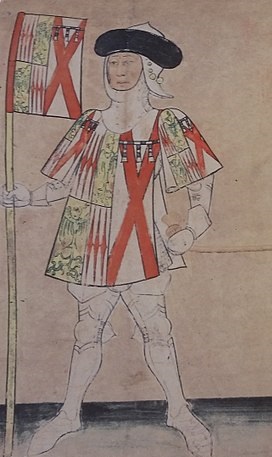Loveday (1458) facts for kids
The Loveday of 1458 was a special meeting held to make peace between powerful English noble families. It happened at St Paul's Cathedral in London on March 25, 1458. This event was King Henry VI's idea to stop the fighting that had started with the Wars of the Roses in 1455.
During King Henry's rule, politics in England became very divided. In 1453, the King became very ill and couldn't lead the government. His cousin, Richard, Duke of York, took over as Protector. York had strong allies from the Neville family, including Richard, Earl of Salisbury, and his son, Richard, Earl of Warwick.
When the King got better a year later, the Duke of York's time as Protector ended. But the arguments between the noble families continued.
Contents
Who Were the Yorkists and Lancastrians?
The people who supported King Henry and his wife, Queen Margaret, were called "Lancastrians." This was because the King belonged to the House of Lancaster. The Duke of York and his supporters were called "Yorkists," after his title.
By the 1450s, the Duke of York felt left out of the government. In May 1455, he led an army against the King at the First Battle of St Albans. In this fight, some of York's main enemies—the Duke of Somerset, the Earl of Northumberland, and Lord Clifford—were killed.
In 1458, the King tried to bring his feuding nobles together. He wanted a public show of friendship, helped by the Church, at St Paul's Cathedral. After many talks, a plan was announced. To celebrate, a procession was held. All the main leaders walked hand-in-hand from Westminster Palace to St Paul's Cathedral. Queen Margaret walked with the Duke of York, and other rivals walked together. The sons of the Lancastrian lords who had died at St Albans took their fathers' places.
The Yorkist lords accepted responsibility for the Battle of St Albans. They were ordered to pay money to the families of the dead lords. They also paid for special church services for those who had died. Some people at the time hoped this would bring lasting peace. Others were not so sure.
Sadly, the King's Loveday did not bring long-lasting peace. Within a few months, small fights between the lords started again. Within a year, the Yorkists and Lancastrians faced each other in another battle, the Battle of Blore Heath.
What Was a Loveday?
In the past, a "loveday" was a special meeting to settle disagreements peacefully. The word "love" here meant agreement or settlement. These meetings were a way for people to solve problems without going to court.
Lovedays were often used by nobles. They helped them avoid involving the King directly in their arguments. These meetings usually happened in a neutral place. Important people, called councillors, would help arrange the meeting. The leaders involved would usually bring a small group of followers. They would then wait for a decision from a small group of trusted people, often three, who acted as judges.
Planning the Peace Meeting
King Henry believed he could bring the two sides together. He called several big meetings in late 1457 and early 1458. The King wanted to make his own decision to settle the arguments.
The first meeting in November 1457 didn't have many nobles show up. But the meeting planned for January 27, 1458, was more successful. Lords started arriving in London a few days before. Each leader brought many armed followers.
King Henry tried to keep everyone safe. He brought soldiers from the counties to protect London and Westminster. He even paraded them through the city to show how strong he was.
On January 26, the Duke of York arrived with 400 armed men. The Earl of Salisbury had 500 men. Soon after, their rivals arrived. These included Henry, Duke of Exeter, and the new Duke of Somerset. They brought 800 men. A few weeks later, the new Earl of Northumberland and his brothers arrived with about 1,500 men. The Earl of Warwick arrived last from Calais, bringing 600 experienced soldiers.
With so many armed men, tensions were high. City leaders worked hard to keep the groups apart. The Lancastrians stayed outside the city walls. The mayor and city council feared a big fight if the groups met. They even armed 5,000 men to patrol the streets.
The King's Decision
The big meeting started on January 27, 1458. King Henry himself appeared before the lords and asked for unity. Then he left London.
Henry returned in mid-February, but soon left again. This made it harder for the nobles to reach an agreement, as there was no one to make final decisions. While the King was away, the Lancastrian lords visited him. This might have made it seem like the King was not neutral.
Discussions finally began in mid-March when the King returned. These talks were long and difficult. The King prayed for a settlement. Finally, a decision was reached. The presence of so many armed men probably helped speed things up.
On March 24, the King announced his decision. The Yorkist lords were blamed for the Battle of St Albans. The King said their actions were "terrible and hateful." He wanted to show that he knew what had happened but also that he could forgive and keep the peace.
The Yorkists had to pay money to the families of those killed. The Duke of York had to pay 5,000 marks to Somerset's family. Warwick had to pay 1,000 marks to Lord Clifford. Salisbury agreed to cancel fines that had been placed on Egremont and Ralph Percy. Salisbury also had to pay 12,000 marks to the Dowager Countess of Northumberland. These payments were not in cash, but by giving up debts the government owed them.
The Yorkists also agreed to give money to St Albans Abbey for two years so monks could pray for the dead. The Lancastrian lords, who were seen as the injured parties, did not have to make any payments.
The Loveday Procession
The peace agreement was announced on March 25, also known as Lady Day. King Henry, thankful for the agreement, joined his wife and nobles in a celebration. They walked in a procession from Westminster to St Paul's Cathedral.
Leading the parade were Somerset and Salisbury. Then came Exeter with Warwick. The King walked alone in his royal robes. Finally, the Duke of York walked with Queen Margaret. Everyone held hands. A writer at the time said, "one of one faction, and another of the other sect, and behind the King, the Duke of Yorke led the Queene with great familiarity."
Historians have different ideas about what this procession meant. Some say it was a strong symbol of friendship. Others think it was just a show. In those days, physical touch was important for showing agreement. The Queen holding York's hand showed her important role in government.
Even though it was called a Loveday, there was still a lot of tension. Salisbury, for example, brought 400 armed men to the church ceremony. One historian said, "the title is ironic, as there was little of love in the air."
After the Loveday, things seemed positive for a short time. The King even allowed Egremont to go on a pilgrimage, which was a way to get him out of the way. The King also visited St Albans himself, showing he was no longer afraid of the place where the battle happened. There were even parties and feasts until May, held at the Tower of London and the Queen's palace.
What Happened Next?
The Earl of Salisbury had a copy of the Loveday agreement made. This suggests he thought the agreement was good for him, even with the payments he had to make. He just had to give up debts that were already hard to collect.
The Loveday also seemed to help Salisbury's son, Sir John Neville, get engaged to a young heiress who was under the Queen's care. This would not have been possible without Queen Margaret's permission. The King also benefited because his role as a peacemaker was made very public.
However, historians disagree on who truly "won" or "lost" at the Loveday. Some think it was a fair deal, and the Yorkists were happy. Others believe it was unfair to them. The Loveday showed that the nobles were still very divided.
The Yorkists, for the first time, admitted they were wrong and accepted blame for St Albans. But this was not enough for the Lancastrian lords, who still wanted revenge for their fathers' deaths. So, it wasn't a lasting solution.
The peace from the Loveday was short-lived. The distrust and plotting continued. The government also made things worse by releasing the Percies, which brought back old rivalries.
In November 1458, a fight broke out between Warwick's men and Somerset's men. Warwick had to escape to Calais. The Duke of York and the Nevilles became more isolated from the Queen's party. Law and order also got worse.
King Henry's efforts with the 1458 Loveday were one of the last times he showed real interest in leading the country. After this, Queen Margaret slowly but clearly took more control. The Duke of York and the Earl of Salisbury went back to their estates. Some historians believe the Loveday, ironically, showed how divided the nobles truly were, and that this was when the Wars of the Roses truly began.
A few months later, in 1459, fighting broke out again at the Battle of Blore Heath. The Yorkist lords were accused of treason. Within three years of the Loveday, King Henry had been removed from power. The Duke of York was killed in battle, and his son Edward became the first Yorkist King of England.
What Did People Think at the Time?
Some people thought the Loveday procession was just a show and didn't mean much. An anonymous poem called Take Good Heed was published, giving advice to the Yorkist lords and suggesting hard times were ahead.
Other writers were more hopeful. A poem called Reconciliation of Henry VI and the Yorkists kept repeating, "rejoice, England, to concord and unity," hoping for a strong and unified kingdom. The author wrote that "there was between them lovely countenance / Which was great joy to all that there were."
But not everyone was impressed. A preacher from Coventry said that the King "made Lovedays as Judas made with a kiss with Christ," meaning it was a fake show of friendship. Enemies may have walked together, but they still didn't trust each other. The writer Thomas Malory also showed doubt about Lovedays in his famous book, Morte darthur. He suggested that attempts to make peace, like building chapels to make up for murders, were often useless.
Why Did the Peace Fail?
The peace made at the Loveday was weak and didn't last long. The Duke of York no longer had a clear enemy in government, so he could only make concessions. But the other side still wanted revenge. The distrust and plotting continued.
The Loveday itself might have made tensions worse. It brought up the question of what really happened at St Albans, but didn't truly answer it. The government also made things worse by releasing the Percies, which brought back old rivalries and changed the balance of power in the north.




